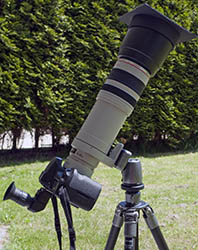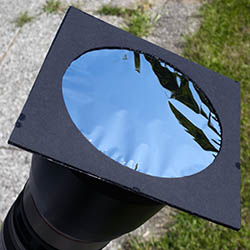Total Solar Eclipse 2009 |
July 22, Hangzou, China. |
My 2009 travel destination was Asia/China. Since there was going to be a total solar eclipse I decided to adjust my itinerary in such a way that I could observe the event. I had never seen a total solar eclipse so the longest of the century was definitely a great opportunity. The path of totality was going to start West of India and then curve Northeast through Nepal, Bhutan, Bangladesh and China and continue over the Pacific, all the way to the Marshall Islands. Since I knew that July is part of the wet season in this region and that monsoon rains and eclipses don't go together very well I had to do some planning. Through the internet I studied some historic weather data. It became clear that, more or less, the further East along the path of totality I would go, the better the chances of clear skies were going to be. The maximum of the totality (6 min 39 sec) was going to be smack in the middle of the Pacific, but average cloud amount didn't really improve much over the Pacific so I settled for the furthest East on the Chinese mainland. For a number of other reasons the Shanghai area was the most suitable for my purposes and I therefore set my mind on going to Jiaxing, just Southwest of Shanghai. A few days before the solar eclipse, after having traveled around China for three weeks, I started checking the weatherforecasts. It did not look good at all! Heavy thunderstorms along the entire path. Besides Tibet there were no areas where predictions looked good or even a little bit promising. Because I didn't have a visa for Tibet and because I just came from that general direction I didn't want to go there. So I looked for a better option. I did find "Steve's WRF: Total Cloud Cover" website which he, as far as I know, made especially for the oncoming eclipse. He had some better news because he predicted that there were going to be some holes in the cloud cover in the Hangzou area around the time of the eclipse. I traveled to Hangzou, with its great West Lake, and the following days I kept an eye on Steve's website and crosschecked his predictions with the actual weather. Especially the Hong Kong Observatory's near realtime satelite imagery proved very useful and the German Wetterzentrale also had some good weathermaps. Steve's predictions remained right on the money and I started to believe that Hangzou was going to be the place to be. Until the night before the eclipse Hangzou remained the most promising location within my potential travel range. On wednesday July 22, the day of totality, I got up at sunrise. And this is ridicuously early in Eastern China without daylight saving. One look out of my hotel window revealed that the sky was fully covered with very thick, dark clouds. Not good. One last check on the satelite imagery showed that the weather had actually deteriorated a little since the night before. But a few hours before the eclipse I had not much options left. Maybe the odds were slightly better to the Southeast towards Shaoxing but then, this was further away from the eclipse centerline and it would not become as dark. So, Hangzou it was, and I went to a little park on the Eastside of West Lake. As the time of the first contact (C1) approached, all of a sudden the sun peeped through the thick clouds. It was only for a few seconds but it definitely lifted our spirits. Because there was a very thin layer of Cirrus clouds the sun could be observed with the naked eye. And then, right after the first contact, the sun appeared again and this time it stayed a little bit longer. In the next hour or so the number of appearances steadily increased. As the time went by it was slowly getting darker, the streetlights were turned on, the temperature dropped noticeably and the crickets finally shut up. About 10 minutes before the start of totality (C2) the sky was entirely free from the thick clouds that had been obscuring the sun most of the morning and only the thin layer of cirrus clouds remained. Divine intervention! During the last moments before the sun was totally eclipsed, an impressive diamond ring revealed itself and then, all of a sudden, wham, totality! It was really pitch dark. The long corona streamers were clearly visible. What an awe inspiring experience. I had goosebumps on my arms which were not caused by the few degrees temperature drop. Despite the fact this was the century's longest eclipse the light raced towards us from the West, over the West Lake, much too soon. When the sun returned (C3) all the people on the square started cheering and applauding. I guess everyone was happy that the moon didn't get stuck or something. With a feeling of satisfaction and triumph I remained in position until the sun had fully recovered (C4). In less than an hour the thick dark clouds started to regrow with a vengeance and about two hours later I was amidst a fullblown tropical storm complete with torrential rain, violent windgusts and numerous lightning strikes. While sheltering from the weather, the news on television did not show much eclipse footage but mostly people with umbrellas trying to keep their footing... |
The Tools |
For the 2009 eclipse I used a Canon EOS 40D with the superb EF 100-400mm lens mounted on a Gitzo tripod. At first I started, as planned, with a 1.4x tele-converter attached but it proved too hard to take pictures of the sun without autofocus (due to the extender in combination with the 40D) and with the continuously changing light intensities. Several times I had a hard time, after the sun had been invisible for a while, finding the sun and re-aiming my camera so I decided to go without the converter. And the many Chinese that kicked my tripod didn't help either. Because of the fast changing light I also had to remove my solar filter and later put it back on again several times. Between C1 and C2 I manually took pictures whenever the sun appeared. I left my automatic remote control snapping away at regular intervals but it mostly took pictures of the clouds. When getting closer to the totality, the circumstances improved steadily and I gradually let automation take over. Especially for this event I had bought a right angle finder which proved worth every penny. Especially because I spent so much time looking through my camera due to the difficult circumstances. Between C3 en C4 the sun remained unobscured and the remote controller did its job and I just had to regularly re-aim my camera. A good indication for the different camera-settings was provided by F. Espenak and J. Anderson. |
The Gear: Canon EOS 40D Canon EF 100-400mm f/4.5-5.6L IS USM (Canon 1.4x extender) Canon TC-80N3 remote controller Gitzo basalt GT1930 tripod with center ballhead Hoodman H-RAV Right Angle Finder Home-cooked solar filter with Baader AstroSolar D=5 foil |
 40D with extender and filter attached |  Home-cooked solar filter |
A special thanks goes to Steve for his excellent forecasting system, "guru" Fred Espenak for making all the necessary data available, Hisso for providing real-time KNMI weather assessments and last but not least Joffels for his mental support and for saving me from being stampeded by overexcited Chinese. If you want to know more about eclipses make sure you check out the NASA eclipse website, the excellent maps on Xavier M. Jubier's site and Fred Espenak's great Mr. Eclipse website. If you want to contact me send an e-mail to |